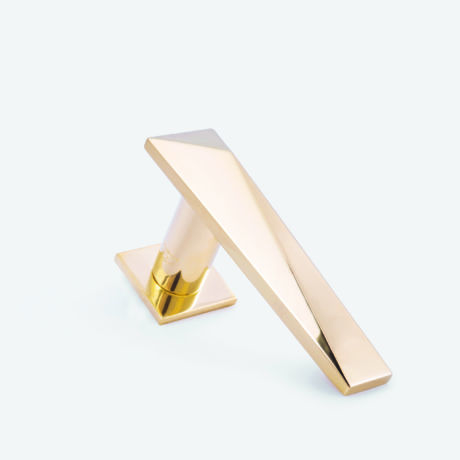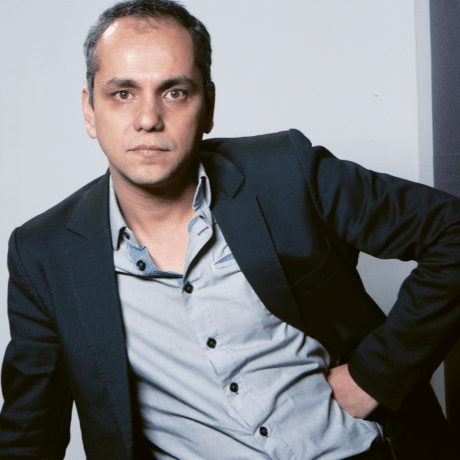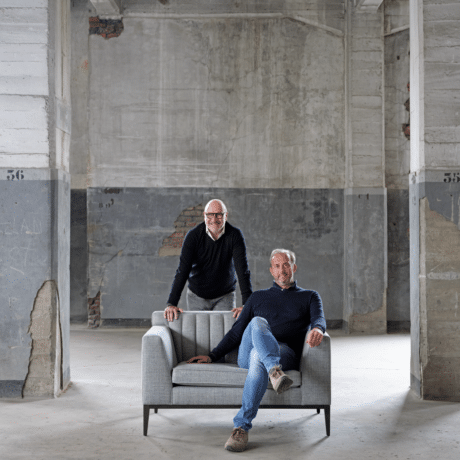
Dossier
Brussels mag N°18
Face-à-face
TEXT MARIE HONNAY - PHOTOS KAREL DUERINCKX
Is cooking an art? To respond to this somewhat delicate question, we asked Pierre Marcolini to invite someone who is close to him to discuss the topic. When Belgium’s blue-eyed boy of chocolate-making gets together with one of the capital’s most talented chefs, the discussion is delightful, passionate and rather spicy.
Pierre Marcolini, what made you want to invite Christophe Hardiquest to this Face-to-Face?
Pierre Marcolini Our friendship started some 20 years ago at least. Above and beyond the respect that I have for his work, we share the same philosophy. The profession of a chef is very demanding. A chef at his level is constantly evolving on a tightrope. His mission is to achieve a perfect balancing act that he has to maintain during the two and a half hours that his clients are seated at table. When someone works like Christophe does with top quality produce, there is always the risk that it will not be delivered on time or in sufficient quantity. In spite of that, you have to be able to offer a constant level of quality without the clients being aware of this pressure. This profession is a balancing act, a theatrical spectacle or a skilfully staged opera.
Can one say that cooking is an art?
Christophe Hardiquest I would say that cooking is based on a real savoir-faire. The artistic aspect is present but it comes in second place. What really counts is to have a veritable culture of the produce. If you can master that, then you can really envisage presenting your produce as a work of art.
PM I think that I would say that cooking is an art from the viewpoint that our profession aims to create an emotion, or even to provoke a thought. As in the case of a painter or a musician, Christophe is searching for the best way that he can express what he feels. His cooking is the reflection of his state of mind. We are both influenced by society. What we create is the reflection of our personal path in life. Everything has to have a meaning. I believe very much in the memory of taste. If, tomorrow, my chocolates could become like Proust’s Madeleine cake for the young people of today, I would consider that I had accomplished my mission.
What is the driving force of your creativity?
ch What counts is the energy that we transmit through our dishes. In the vision of a modern enterprise, it is impossible to confine oneself to just looking at turnover figures. The impression that we make is of capital importance.
PM We are what I like to call ‘the children of the stolen recipes’. When we started to learn our profession, cooks did not share their savoir-faire. You had to be cunning to capture a recipe or a chef’s secret. Today, the idea of sharing is at the very centre of our approach. In January 2019, when Christophe gathered together chefs from around the world for a charity evening at his restaurant, we experienced moments of extraordinary sharing.
Is contemporary art a source of inspiration for you?
ch A few years ago, I created Poulpe Pierre Soulages, a dish based on cuttlefish ink and smoked octopus. Pierre and I are veritable sponges. Everything that we see, hear or perceive, whether it is a shape, a colour or a sound, influences us. This sensitivity allows us to stay connected with the world. For me, luxury is derived from the notion of respect for the wok of other artists and artisans. When you see a beautiful item of clothing or an object fashioned in accordance with the rules of art, you cannot be indifferent. In recent years, I have collaborated on several occasions with some of our capital city’s greatest talents: the Niyona fine leather goods studio which created leather table sets for the restaurant, as well as with Maison Vervloet. Collaborating with the wrought iron art works atelier, the designer Jean-François d’Or designed an object for us with an almost surrealist air. We also entrusted the Brussels firm Scabal with the task of designing clothing for our restaurant personnel. The talent of all these enthusiastic artisans has given a real added value to our vision of luxury. Our approach is often quirky and full of humour, but, whatever happens, we do everything possible to aim for excellence and flee from any form of mediocrity. We also owe it to ourselves to be ambassadors of Belgian quality.
PM I have the incredible good fortune to have a wife who is an artist (Valérie Boucher, Editor’s note), who is very involved in our capital’s cultural life. ArtContest, the competition that she organises every year enables me to meet with future artists and also members of the jury: the Brussels gallery owner Albert Baronian and Dirk Snauwaert, the artistic director of Wiels. When we travel, I am always in charge of finding the best restaurants. Valérie takes care of nourishing my soul. In concrete terms, I am always surrounded by talented artists and creative types: Charles Kaisin has developed a good number of design projects for chocolate-making. For his surrealist dinners, we have created totally crazy desserts such as Caesar’s sweet finger. Through contact with Marie Taittinger, I also came across the French artist Daniel Firman. The experience that we had with him, also completely surreal, consisted of creating chocolates with a mould made from a chocolate base that he had mashed up beforehand. This was an artistic performance rather than commercial which had the sole objective of proving that one can push the limits of creativity very far while maintaining a real respect for the product. As Christophe says, what is beautiful about luxury is the gesture and the savoir-faire. The place where we are now is the best proof of this. Italian cuisine is more often than not a meagre cuisine, but it is always authentic and generous.
In your work, and this applies to both of you, there is always the concept of commitment. Can you explain this?
PM It is work where memory plays a role. Christophe revisits the culinary heritage of the capital. His signature dishes are a way of paying homage to our recipes and the nobility of our produce, such as horsemeat which for him is an honour to prepare in a way that reflects the tastes of today.
ch Today, in a world that is turning faster and faster, it is essential to be able to hang on to the concept of identity. National pride is not an idea that I take lightly.
PM You simply have to taste Christophe’s fries, the world’s best in my view, to understand that luxury has nothing to do with the price of things. One can never stress strongly enough how important the essence of gastronomy is: a way of paying homage to all the talents that have contributed to making this dish such a success. In a restaurant, the service is also an art that demands adaptability and a high degree of flexibility. The staff must be attentive and considerate without being intrusive, for example, one should never disturb a client in the midst of a declaration of love.
Do you ever feel anxious about a blank page or an empty plate?
ch In our profession, we can distinguish three phases: firstly, the construction when we are building our identity. This is a time of great doubt; we wonder whether what we are doing will please, if we are going in the right direction. The second phase is consolidation. We become more confident in our abilities before the last phase. This is the phase where we are now, Pierre and I. Today, our goal is to perpetuate our project. To achieve this, we are developing a hyper-creativity. We relax, we are enjoying ourselves. We are tired but …. very happy.
PM Laurent Soenen, my closest colleague, has a habit of saying, ‘Pierre’s dreams are the beginning of my nightmares’. Our role consists of capitalising on the past in order to transcend it. Tastes change. Recipes and codes must also change. Desserts are less sweet and contain less alcohol than before. Dishes are inspired by world cuisine. Our art is part of a greater project where the notion of commitment to society has become more crucial than ever before.


Dossier

1 establishment, 3 trades

Portrait

Graphic art

Behind the scenes

7th art